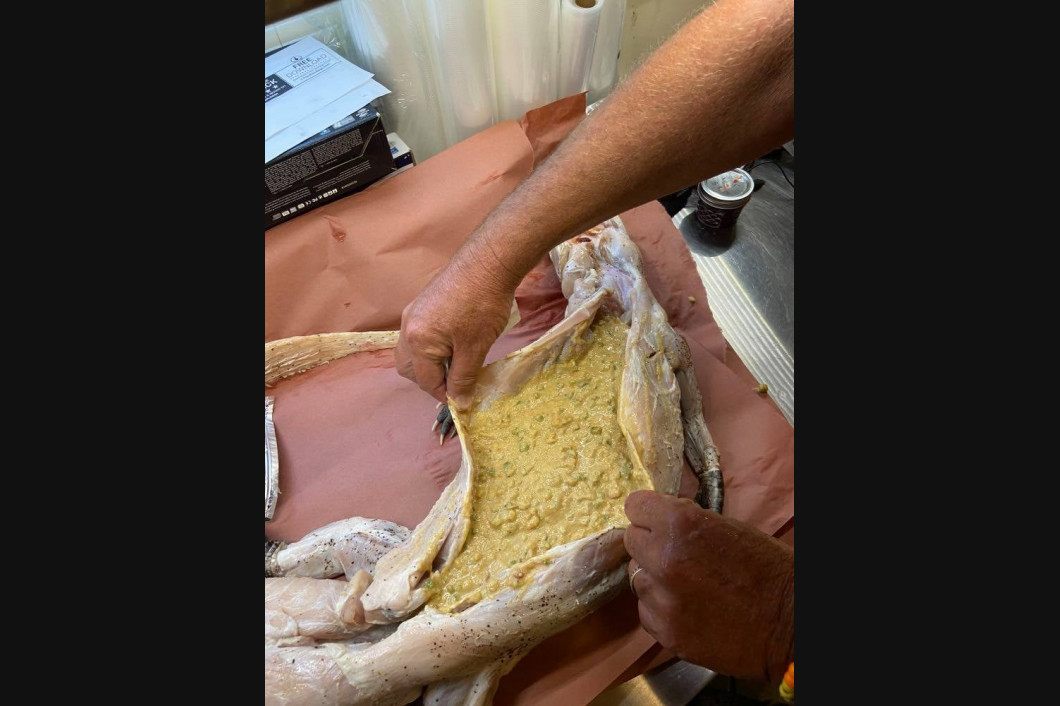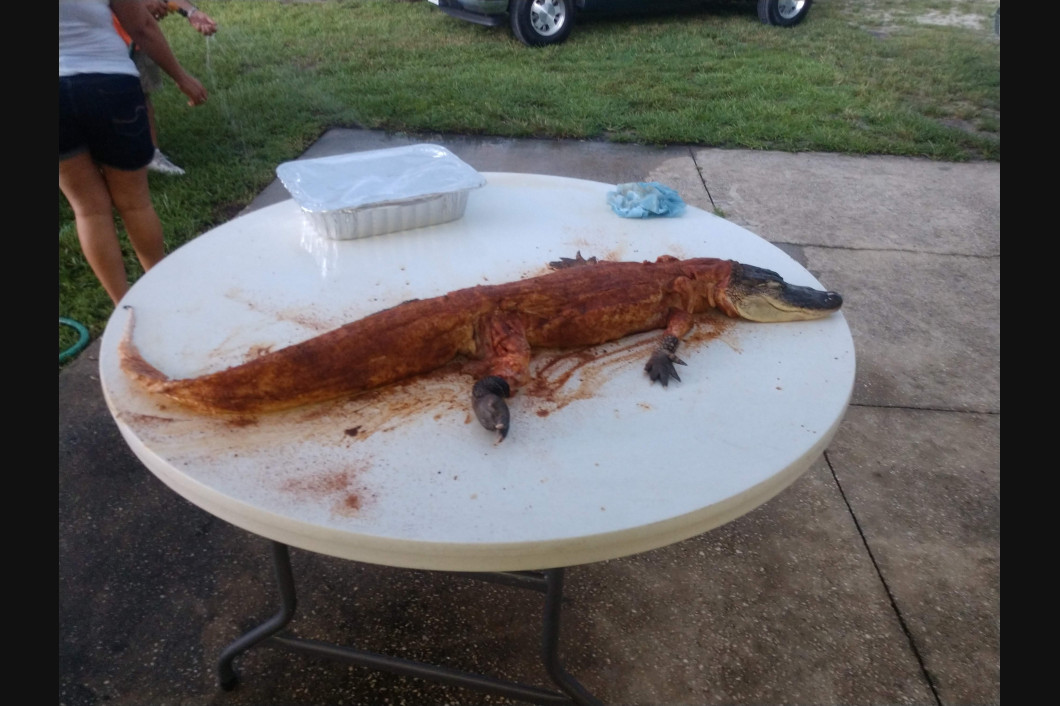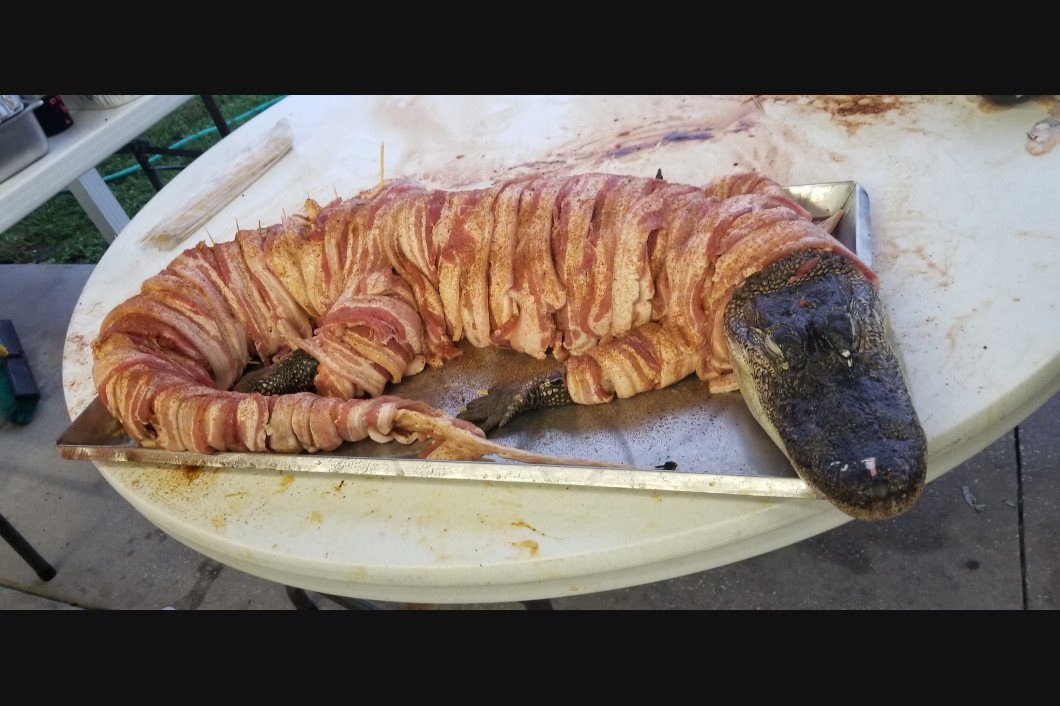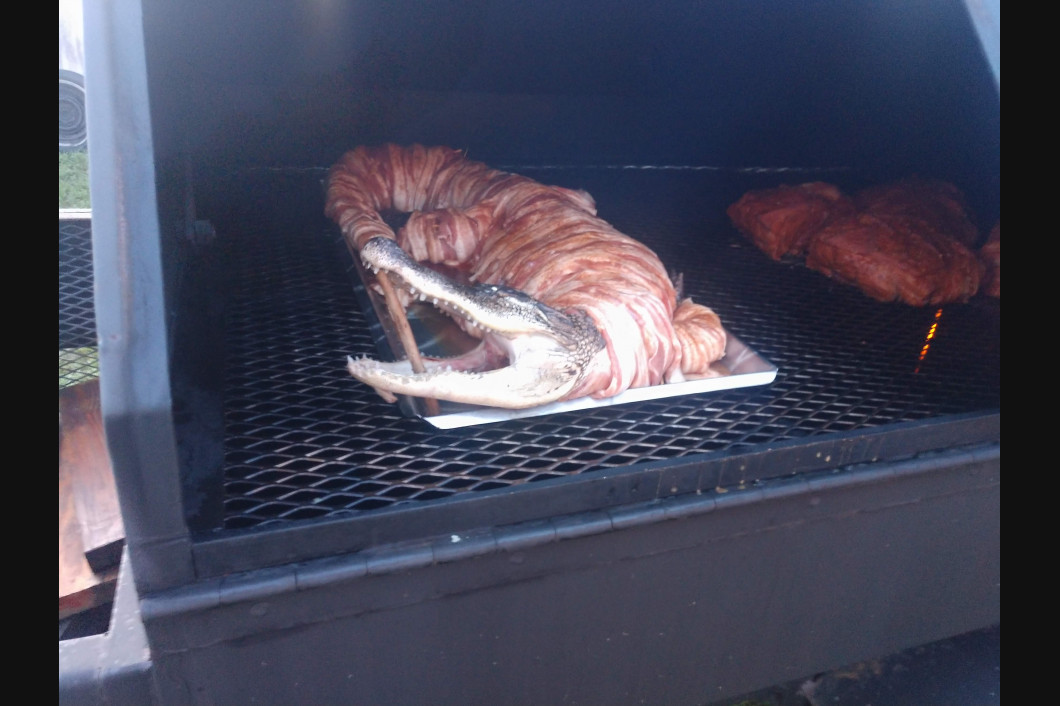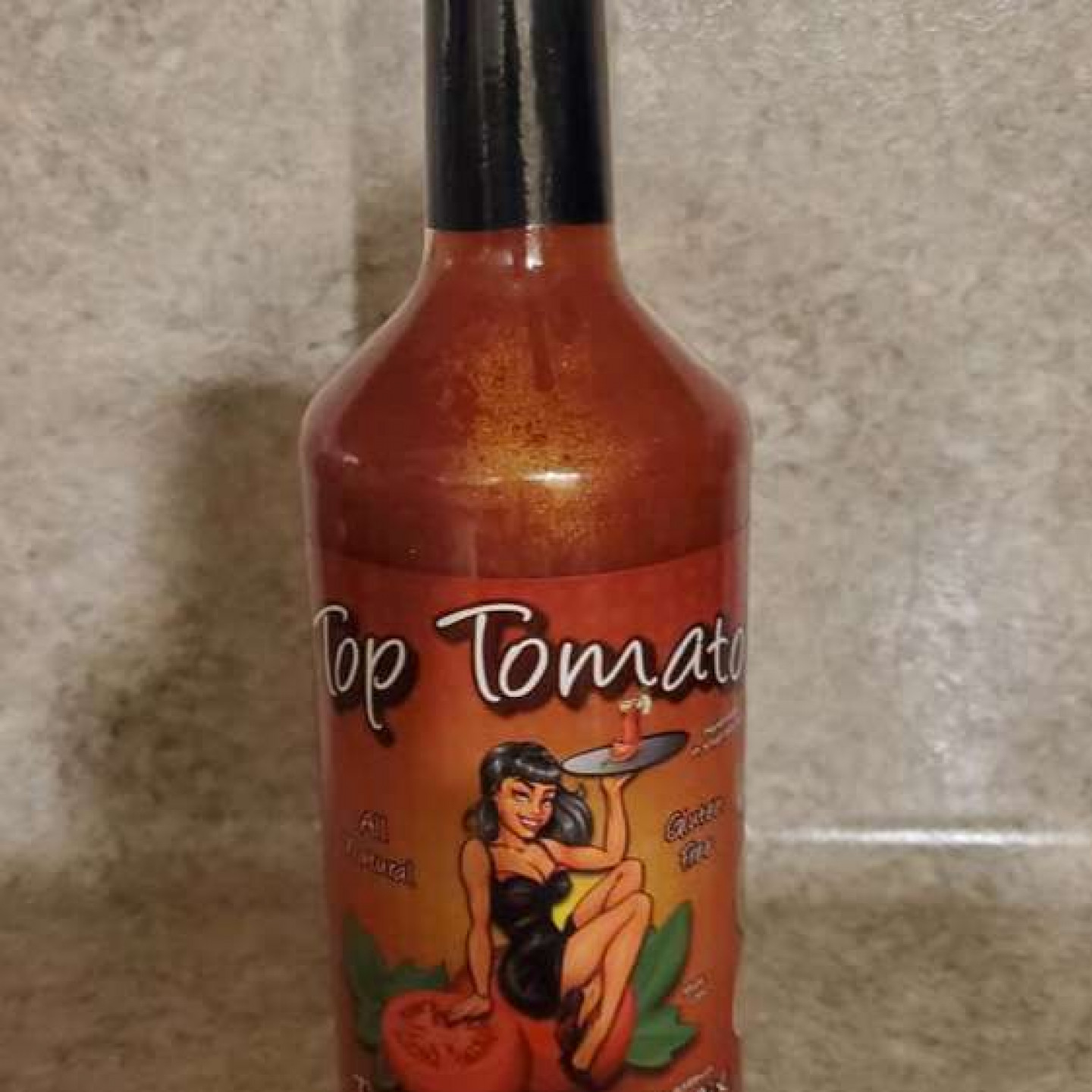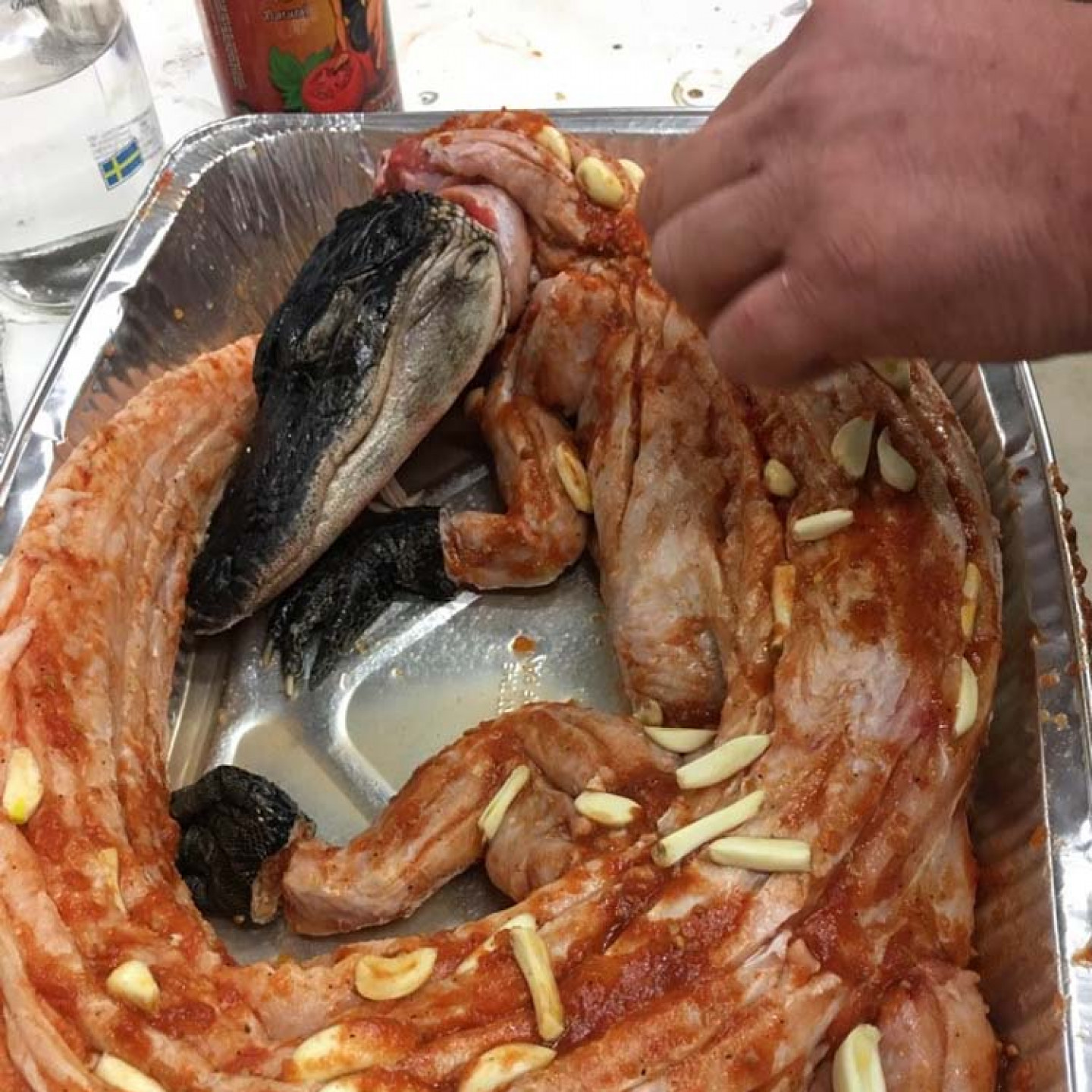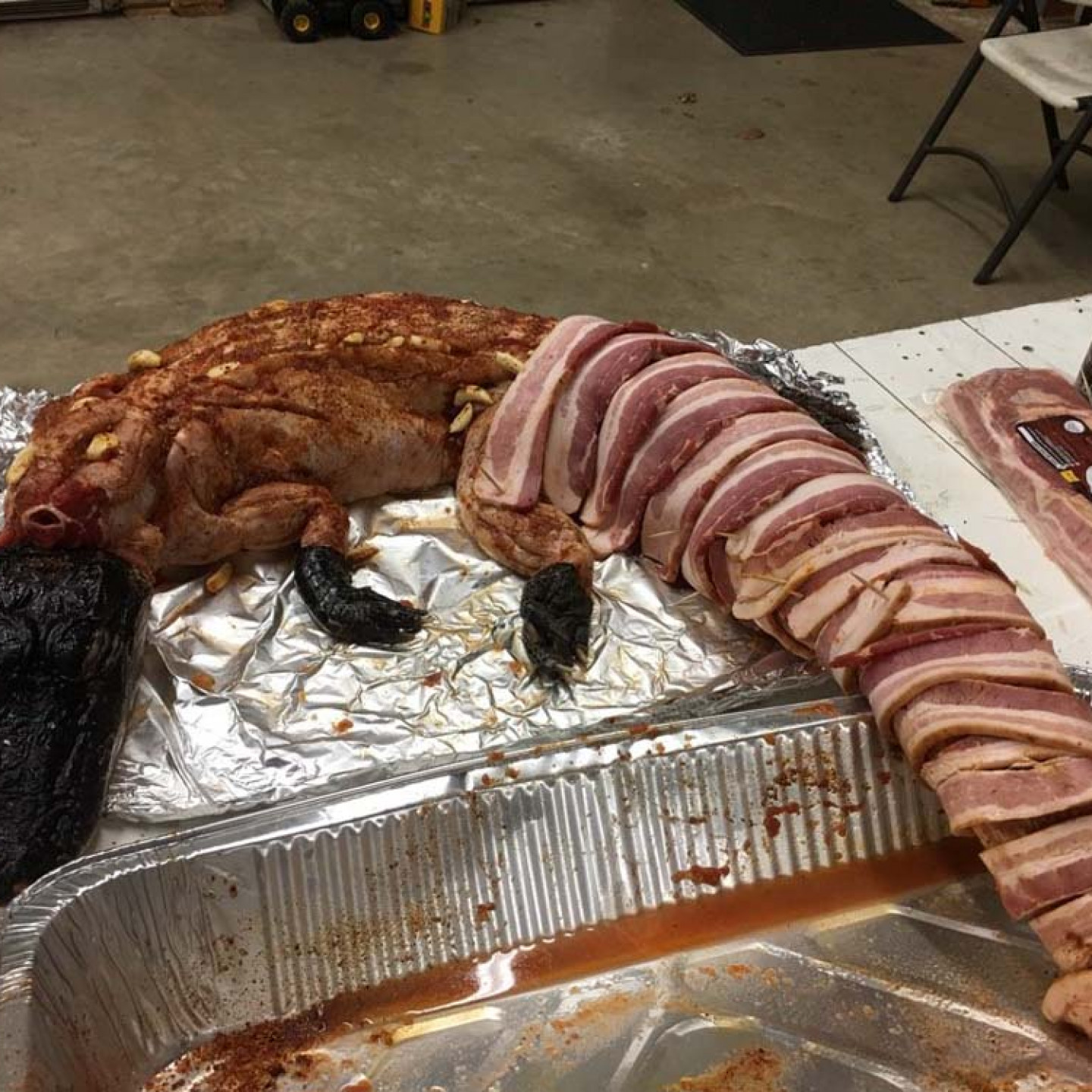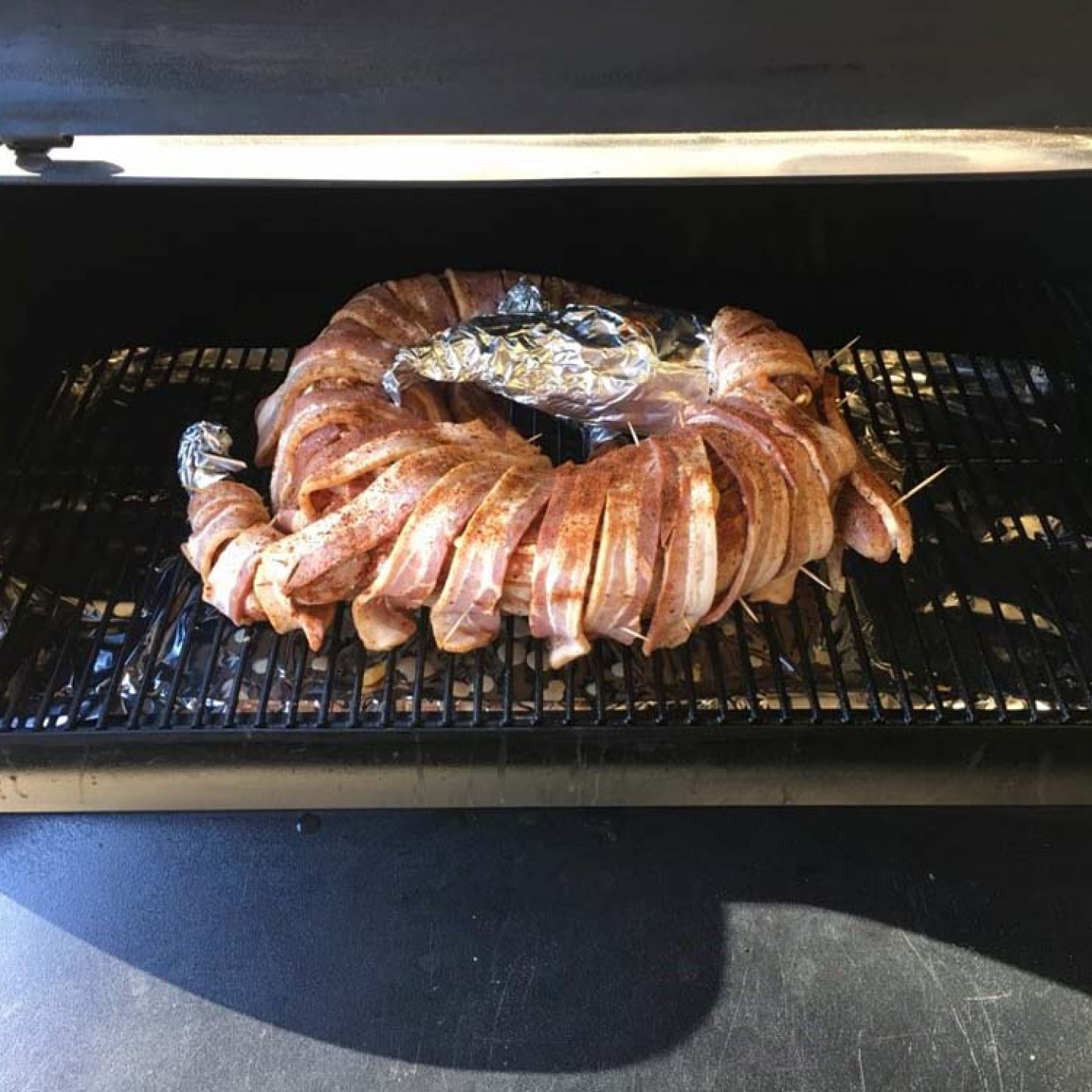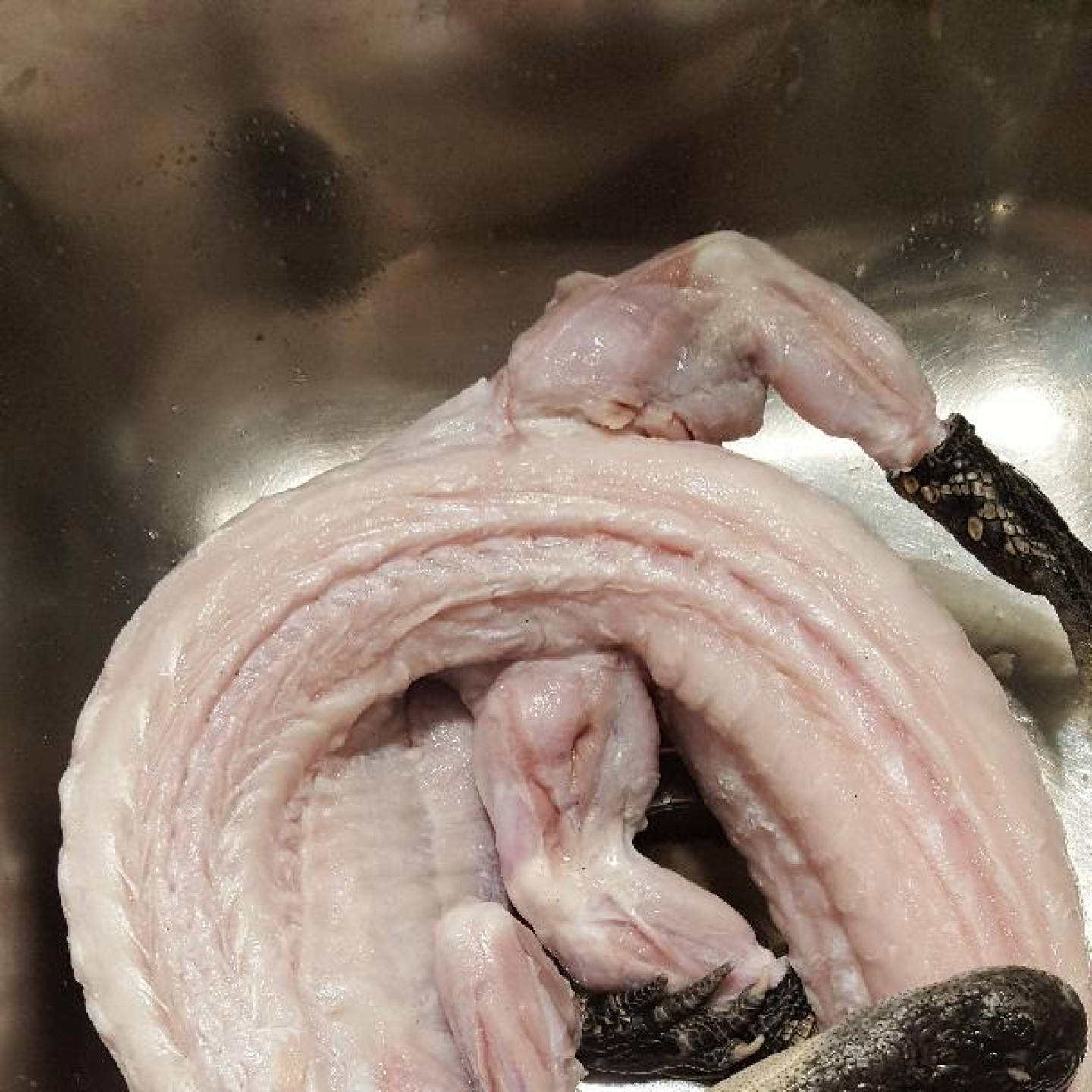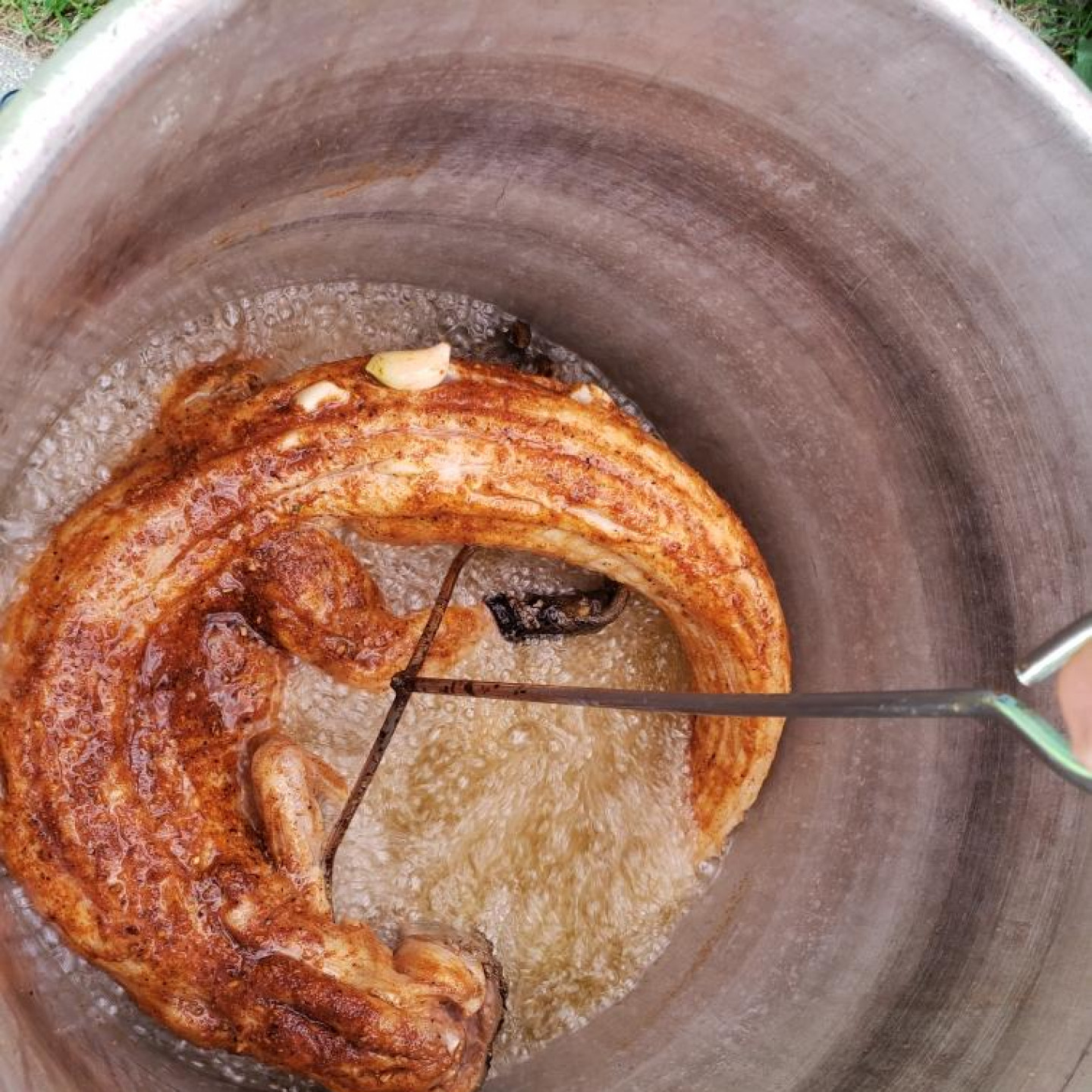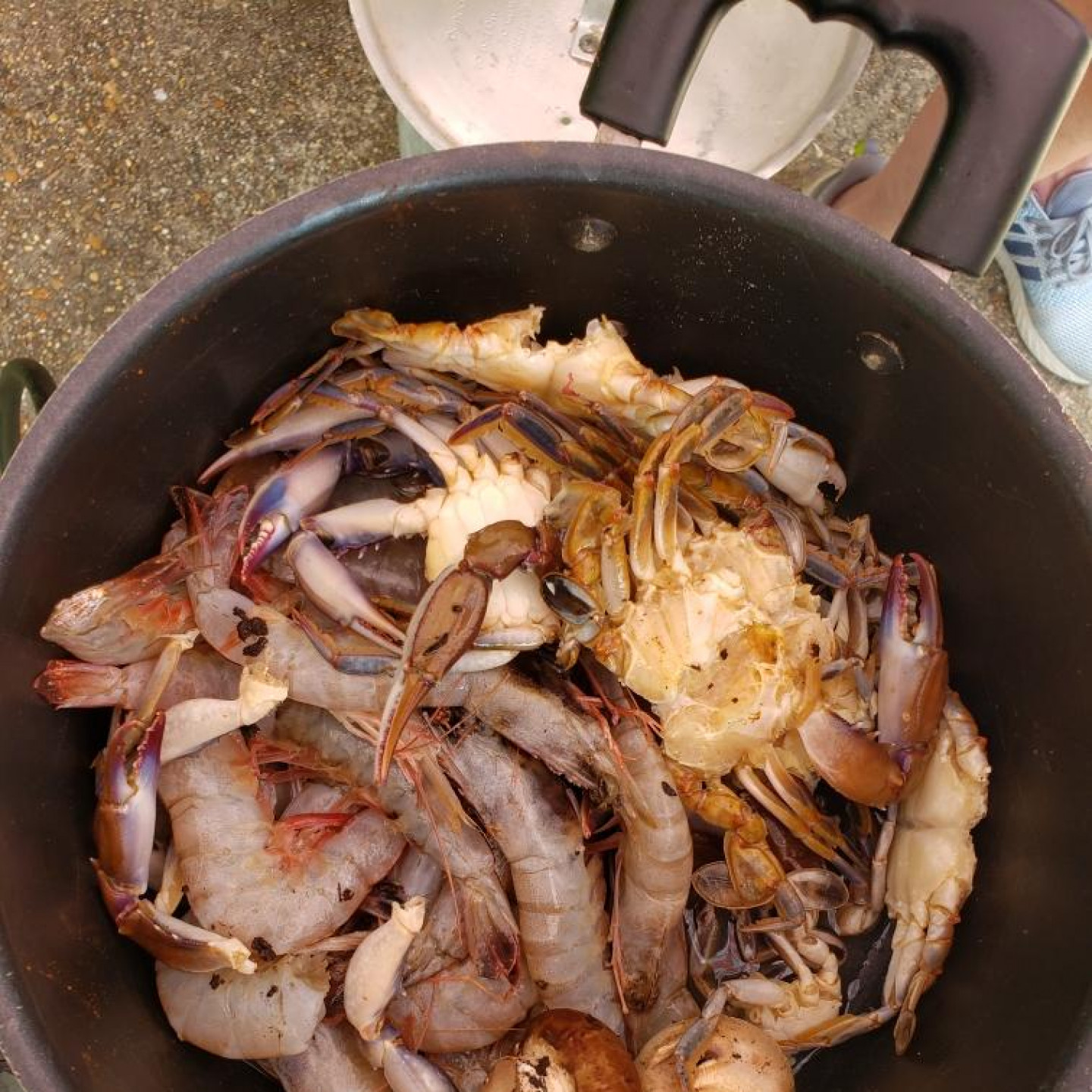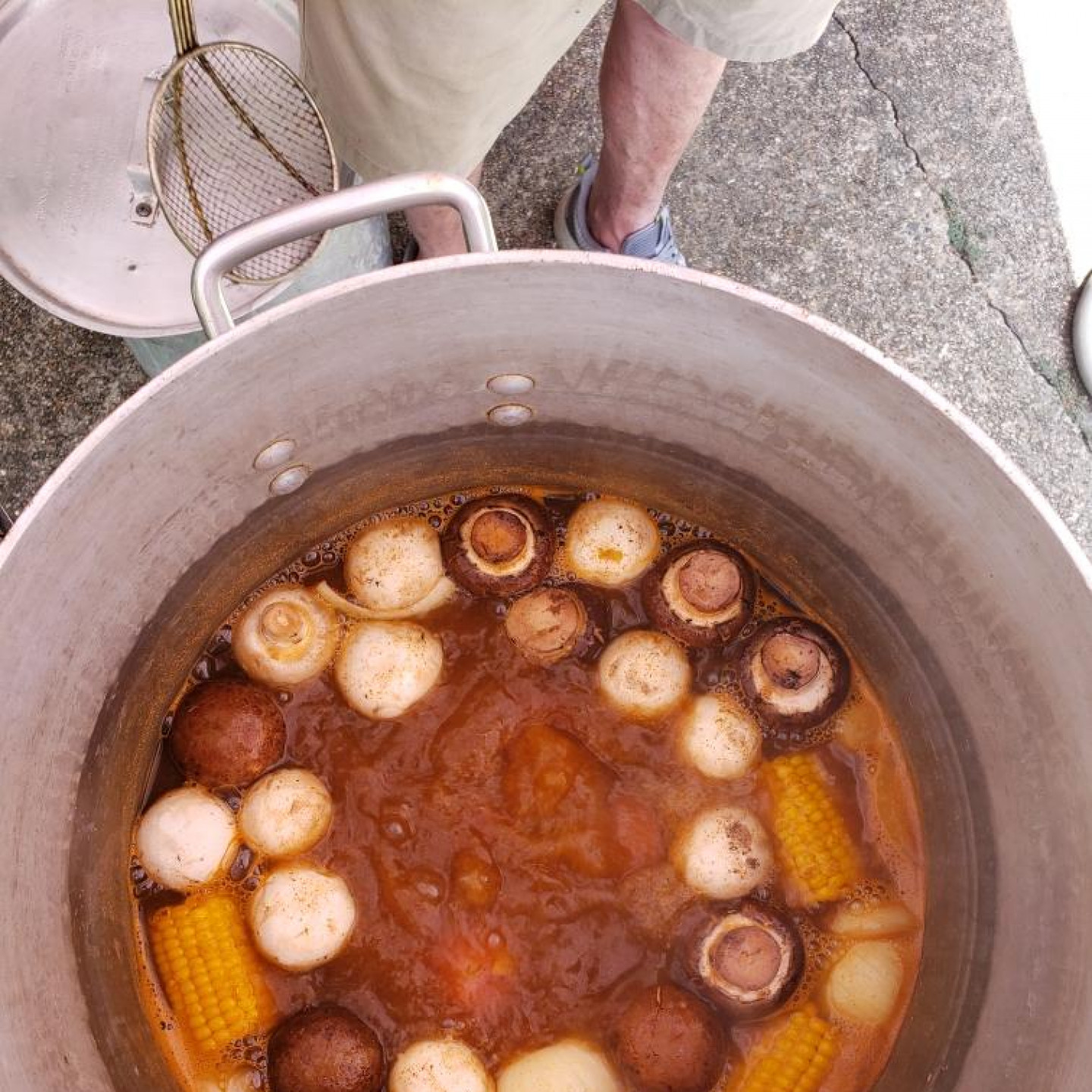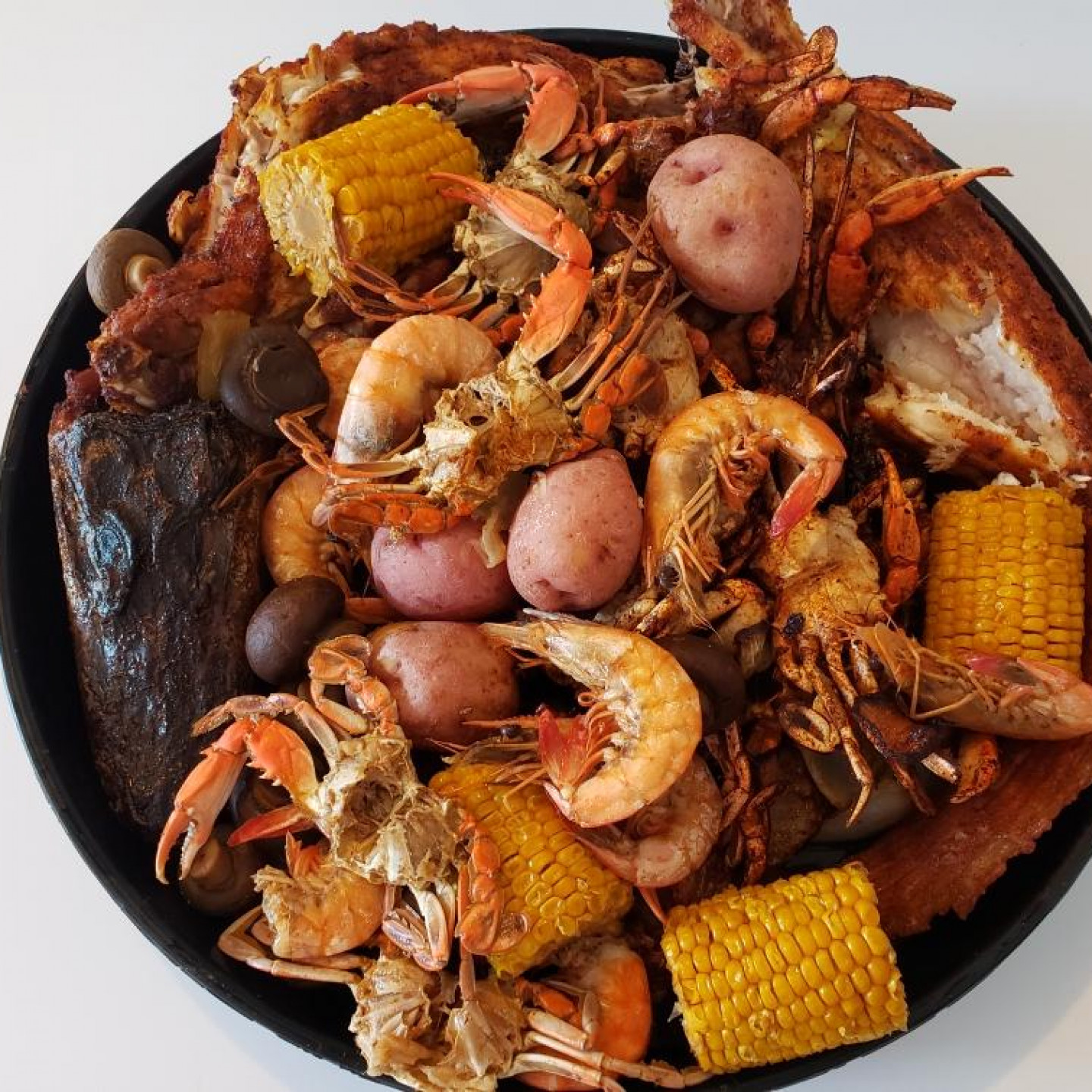Follow Us x
Grilling or Smoking an ALLIGATOR
HELPFUL HINT: due to the process that the farm uses to remove the skin of alligator (air tool), the removal of the fat inside the alligator they might cut the skin. When you are cleaning out and prepping the alligator, you will notice 1-2 slits. You already have the tools to repair them since you will be sewing up the carcass after you stuff.
As my Grand Ma would say while she was thumping you on the head to ask so many questions when you wanted to know how she cooked food you loved. Now, she was all of 90 lbs., but you would think the thump came from a 240 lbs. man. Then she would say KISS is how we do it. I am 70 years old, so when you are told KISS at 10 years old, you have no idea what she was talking about. Then she explains we are going to (KEEP IT SIMPLE STUPID). So, I will try not to have flashbacks and give you this recipe. You can always adjust it to fit your needs.
- Put your alligator in the refrigerator 2 days ahead of cooking it to thaw (but you can always shortcut it by putting it in water.
- Before you start preparing the alligator, get your smoker or grill going (you want your temperature to be 250-275 degrees).
- After the alligator is thawed out, we are going to open the cavity and clean it out. I usually take a large spoon and scrape the inside, and then I cut off any fat or pieces of meat that might be hanging from them, cutting the alligator open.
- After I have washed the inside and outside, I pat the alligator (DRY). Next, we will cut slits about an inch long down the back, sides, legs, and tail meat. Make sure you make several slits. Then I usually take between 4 and 6 slits and make them a little deeper, this is because I like garlic, so I am going to stuff a clove each in those 4-6 slits.
- Now we start getting into the fun stuff; I look around for my favorite nightcap (Jack Danial's) and rub a generous amount onto the alligator. I want to be able to have something for my rub to adhere to. Now, this is one that I added that Grand Ma did not teach me; she used (Moonshine). Most of us have our favorite rub that we use when we are grilling or smoking our food. Do not change just because it is an alligator. The alligator is a lump of lean meat with almost no fat, so it will take to the flavor you put on it. You can use a rub that you find in the Cajun section of your local market if you choose. (or you can check out our friends at BC Seasonings & Rubs)
- When you put your rub-on, make sure you cover everything. With the alligator being such a (lean meat), we are going to (wrap it in bacon). We try not to use smoked bacon, no problem if you do (no competing flavors) with our rub. We don't want our alligator to dry out and keep splintering during the late stages of the cooking.
- It's time to put your handy work on the smoker or grill. Make sure your temperature is between 250-275 degrees and steady. Depending on the weight of the alligator, this will be a 4-hour process. The most important part of cooking comes into play now. We want to keep checking the meat at the thickest part of the alligator, which is behind the back legs where the tail comes off the back. You want your temperature to be between 185-190.
- If you want to save the Head or Feet (great back scratchers), wrap them in aluminum foil.
- Many people brine their meat, and that's okay; I usually do not, but when I have, I put it in (buttermilk for 2 days in the refrigerator) with a little seasoning like bay leaves thyme and whole allspice.
Enjoy everyone, and please like us on FB at Big Pop's Fresh Louisiana Seafood Or bigpopslagator.com.
STUFFING FOR WHOLE ALLIGATOR
Follow step by step process and see photos below
This is going to be a hard recipe for me to write. I know most of you cooks like a precise recipe to go by when cooking something new. The only problem with this is you have different size alligators that you will be working with. I want you to notice the picture of the ingredients I have prepared for the stuffing and placed in quart bags. This allows you to use your cooking eye and put in what you need if it is a larger Alligator. I usually cut up a little more then I need and can save the rest to put on an Alligator Taco Salad or Tacos for the next day or if we have any left-over meat. So, this recipe is for a 10 lb. alligator and you will have to adjust for a larger one.
I start out by putting my eggs in a bowl and whisking them, I then put ½ the stock in and leave the rest of the stock for later. Place in all the other items and whisk while you are doing so, by leaving the stock to last this gives me a chance on having the thickness of the dressing I want to obtain. Now I like a wet mixture of corn bread stuffing since it is going to be cooking so long and I do not want it to dry out.
Recipe: Corn Bread Stuffing
1) 2 to 4 eggs, slightly beaten
2) 4 to 6 cups of chicken or shrimp broth, (2 cups to begin with)
3)1 cup of red bell pepper (not small I like to see what I am eating)
4)1 cup yellow bell pepper (not small I like to see what I am eating)
5) 1 cup of chopped celery (not small I like to see what I am eating)
6) 1 cup of chopped onions (not small I like to see what I am eating)
7) 1 cup of mushrooms (not small I like to see what I am eating)
8) 1 cup of green onion chopped (not small I like to see what I am eating)
9) Add package of Crawfish Tail Meat (I can ship with your order and sausage if you wish)
10) 4 bay leaves crumbled up
11) 4 tbsp. of parsley
12) 1 to 2 tbsp of Tony Chachere's again to taste do not make it to spicy for you guest.
13) 1 tbsp of Lea & Perrins better known as Worcestershire Sause
14) 1/4 cup granulated garlic less or more depending your taste
15) salt and pepper to taste
16) If you have never sewed up an alligator you will see the tools in the picture (find at any grocery store) you will need. Just run the loop through and back and loop make your stiches about ½ inches apart.
I like Jiffy Mix. You may have to use 2 to 3 boxes. Pour it in the bowl with the rest of the ingredients and mix. REMEMBER THE CORN BREAD WILL COOK DURING THE GRILLING. Now add the rest of the stock, we want to have a wet stock so did not be shy it may take more the 2 cups.
(PLEASE PUSH THE ARROWS BELOW TO SCROLL THROUGH EACH STEP)
BLOODY MARY ALLIGATOR
Click To Check out our segment on KTBS! >
Defrost and Prep your Alligator.
1. Put your alligator in the refrigerator 2 days ahead of cooking it to thaw (but you can always short cut it by putting it in water)
2. Before you start preparing the alligator, get your smoker or grill going (you want your temperature to be 250-275 degrees).
3. After the alligator is thawed out, we are going to open the cavity and clean it out. I usually take a large spoon and scrape the inside, and then I cut off any fat or pieces of meat that might be hanging from them cutting the alligator open.
4. After I have washed the inside and outside, I pat the alligator (DRY).
For the recipe..
1) The night before take you gator and place it in a tray or on a cookie sheet. Then start to make deep cuts along the legs and down the back and deeper on the tail. This can be done along the left and right sides that is where our Tenderloin and Sirloin are. You can also go to our FB Page and find a video of me preparing one on KTBS TV's Rick Rowe Show.
2) Slowly Pour your Favorite Vodka all over and rub it in good to make sure it gets down into the slits.
3) Next, we do the same with our Bloody Mary Mix.
4) Let it set over night in the Refrigerator if you have room if not prepare the next morning.
5) Next morning, we want to repeat the steps we did the night before.
6) Now we are on to stuffing our gator, use your Grandma's Corn Bread Dressing or mine you can find on website and add a few things. You can add sausage, shrimp, crawfish tail meat, cream cheese, whatever your heart desires.
7) Now we take our rub, remember our gator is a very lean meat and it will take on the flavor you add. So, whatever you do keep using your own rub unless you want to try something different. There is no need to change up just because it is a gator. If you like to inject, please do so in the tail.
8) We need to wrap the gator in bacon, to add flavor and to help keep the gator moist during cooking.
9) We want to cook it at 250-275 degrees until the thickest part of the tail reaches between 185-190 degrees. When that happens, it is ready to eat.
10) Set back and enjoy the time you have had with your Family and Friends in preparing this Unique Louisiana Delicacy.
11) After the gator is ready to eat you will ENJOY the tasting of something you have created. And please send us a picture so we can add it to our wall!
Brimming and Deep-Fried Whole Alligator
1) We brimmed the alligator for 36 hours in:
- Buttermilk
- Garlic
- Onions
- bay leaves
- Black pepper corn
- Dill seed
- Thyme
- Whole allspice
(You choose how much to use because of the size for alligator you might have)
2) This morning we washed off the buttermilk and let the alligator rest for about an hour.
3) After we wash off the buttermilk, I went back to our Cajun Cooking King Justin Wilson. He uses wine in everything he cooks, so today I washed my gator down with a white wine I found in Missouri (a late season grape, Velvet White)
4) We cooked shrimp, corn, potatoes, onions, mushrooms, gumbo crabs in the shrimp boil
5) My son made his rub but I could only get a few things before he hid the rest.
He used some:
- Pork Rub
- Garlic Dry Rub
- Chicken'n Rub
- N'Orleans Cajun Rub
6) In the pot with the gator I also put some gumbo crabs to deep fry along. We will be cooking the alligator at 350 degrees, depending of the size you want to use 3 minutes per pound for a average time. But (most important is you meat temperature in the thickest part of the tail reaches 190 degrees) then it is ready. So start taking the temperature after about 15 minutes.
Simple Brine
Brine:
A container to put the gator in (a small ice cooler works well).
Cover the bottom of the cooler with about 3 inches of ice.
Enough water to cover the gator (6 gallons were used in this recipe).
1 cup Kosher or sea salt per gallon of water used
3 cups brown sugar
2 cups white sugar
8 lemons
8 oranges
Set for at least 24 hours and add ice as need to keep cool, unless you have room in the refrigerator.
Brined Kosher Salt and Honey Alligator by Martin Fenstertock & Benjamin Vega
Patted dry seasoned with Kosher salt and Cajun seasoning then wrapped in 8lbs of bacon then drizzled with a mixture of olive oil, chipotle peppers in adobo, and a tin of fresh garlic. Basted it with that every hour. Took 5 1/2 hours and the meat melted in your mouth. As you can see from the pics we also smoked a chicken in its mouth.
Quick Thaw
If you need to thaw your gator quickly, we are going to do it in water. Please take off the bag; it still will be wrapped in the FDA wrapping, then as it starts to thaw out, pull it off. You can place it in the container you received it in or a cooler; we want to put tap water. The water will turn ice cold; it is just like you put a huge block of ice in it. Wait about 1 hour and pour it out and replace it with fresh water. It will want to float, so weigh it down; I use a pot of water to sit on top of it.
If you decide to do a cold bath, make sure you tell your better half where you put the gator. You DON'T WANT her to open the curtains to have this. It will take a couple of days for her to get over it.

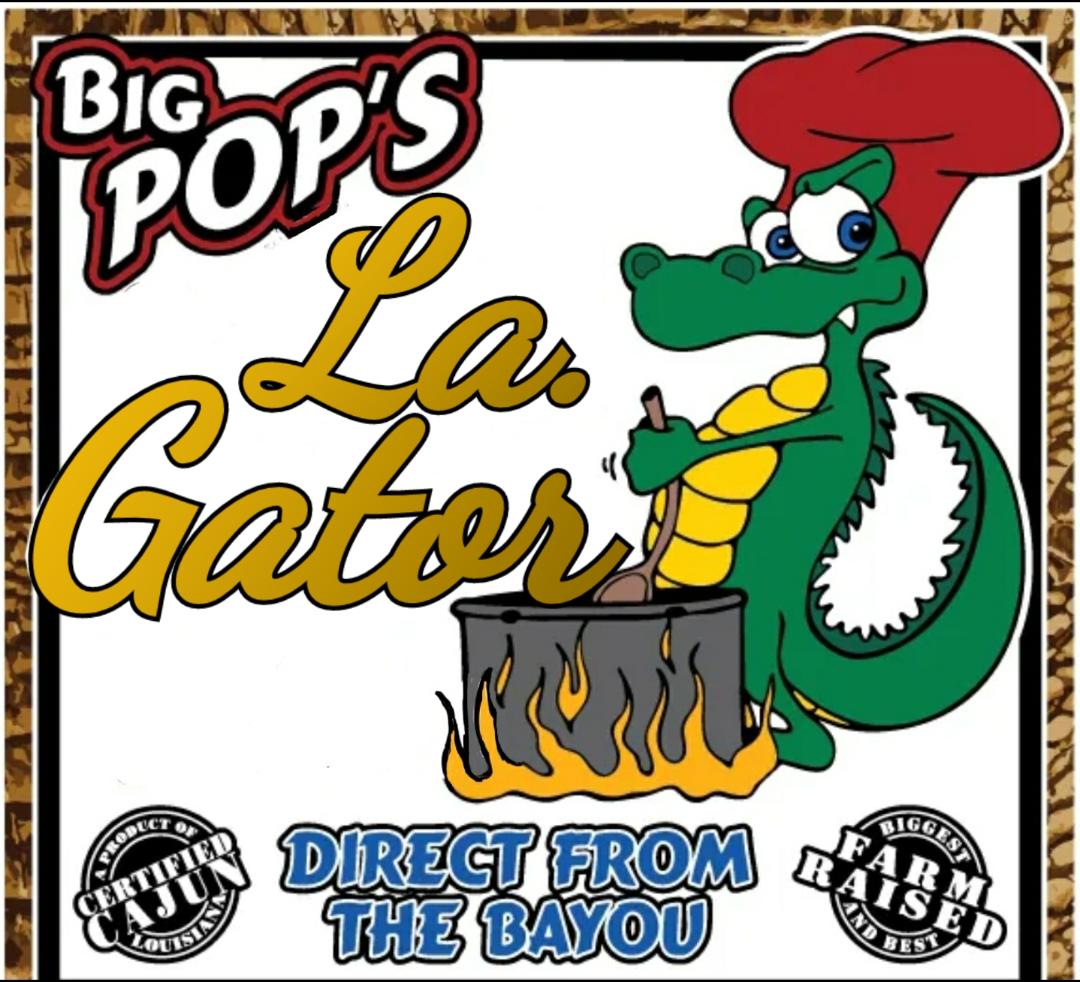



_2.jpg?w=1060&h=706&zc=2&cc=111111&a=t)
_2.jpg?w=1060&h=706&zc=2&cc=111111&a=t)
_2.jpg?w=1060&h=706&zc=2&cc=111111&a=t)
_2.jpg?w=1060&h=706&zc=2&cc=111111&a=t)
_3.jpg?w=1060&h=706&zc=2&cc=111111&a=t)
_3.jpg?w=1060&h=706&zc=2&cc=111111&a=t)
_3.jpg?w=1060&h=706&zc=2&cc=111111&a=t)
_3.jpg?w=1060&h=706&zc=2&cc=111111&a=t)
.jpg?w=1060&h=706&zc=2&cc=111111&a=t)
